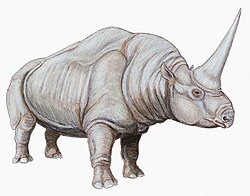| Pseudhipparion | |
|---|---|
 | |
| Pseudhipparion retrusum skull, Museo di Paleontologia di Firenze | |
| Scientific classification | |
| Kingdom: | Animalia |
| Phylum: | Chordata |
| Class: | Mammalia |
| Order: | Perissodactyla |
| Family: | Equidae |
| Subfamily: | Equinae |
| Tribe: | † Hipparionini |
| Genus: | † Pseudhipparion Ameghino, 1904 |
| Species | |
| |
Pseudhipparion is an extinct genus of three-toed horse endemic to North America during the early to late Miocene. [1] [2] [3] [4] [5] They were herding animals whose diet consisted of C3 plants, implying that they were grazers. [6] [7] [8] [9] [10] [11] [12] Fossils of Pseudhipparion have been found in Georgia, Florida, Oregon, Montana, Kansas, Texas, Nebraska, and South Dakota indicate that it was a lightweight horse, weighing up to 90 pounds (40 kilograms). [13] [14] [15] [16] [17] [18] [19] [20] [21] In 2005, fossils were unearthed in Oklahoma. [22] Seven species of Pseudhipparion are known from the fossil record, which were very small, following the trend of Bergmann's rule. [23]








